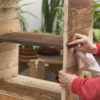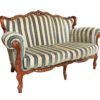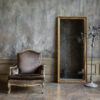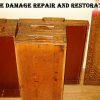Mold spores exist everywhere in the outdoor environment and can easily get indoors through open doors and windows or attached to clothes, shoes, bags, etc. Once they enter the home, the spores stay dormant, waiting for the right conditions (organic food source and moisture) to start developing.

Leather couches and fabric covered chairs provide excellent food for mold development.
Upholstered furniture, such as leather couches and fabric-covered chairs, provides an excellent food source for mold. As soon as there is enough moisture in the home environment (whether from condensation, flooding, or some other cause), mold will begin to grow on the porous upholstery materials. Mildew stains will appear on the upholstered surface and the furniture will start to smell musty and stale. Unless the problem is promptly dealt with, the harmful fungi will cause the leather or fabric to deteriorate and will completely destroy the furniture. What’s more, the mold spores will start spreading to other household materials, causing considerable structural damage and posing serious health risks to the occupants of the home.
To avoid such troubles and save your furniture, you need to take quick and efficient measures at the first signs of mold growth on your upholstered pieces. If your leather sofa or fabric chair is dusted with green (or white, or black, or gray) or smells musty, you have no time to waste – the piece must be cleaned and dried out without delay, so that the mold spores are removed before they can cause further damage.
Here is how to clean mold from upholstered furniture – thoroughly and effectively – to save yourself headaches and money down the road:
Prepare Properly
When dealing with mold and mildew, you need to take some important precautions in order to ensure your safety, prevent the harmful microorganisms from spreading into your home, and effectively get rid of the mold:
1) Take the affected furniture outside – When cleaning mold from furniture, it’s best to do it in an open, well-ventilated area:
- Once you start cleaning the piece, mold spores will be released into the air. To keep them from spreading into your home, you need to complete the job outside;
- Mold is caused by moisture, so it’s preferable to clean the furniture in a dry environment. Taking your affected piece out on a non-humid day will give it the opportunity to dry out, which will make mold easier to remove. Besides, the ultraviolet rays of the sun have a natural sterilizing effect and kill mold, so you may want to let your furniture sit in the sun for a few hours before you start cleaning it. Keep in mind though that direct sunlight may cause the upholstery colors to fade and decide if it’s worth the risk.
If it’s impossible to take the furniture piece outdoors (or the climatic conditions are not appropriate), ensure that the room you’ll be working in is properly ventilated (keep the windows open, use fans, etc.) and the indoor humidity is low (run a dehumidifier, if necessary). Keep the door of the room tightly closed to keep the mold spores from traveling around your home and prevent cross contamination. Also, be sure to put newspaper underneath the furniture to “catch” the mold spores that you’ll be removing.
2) Inspect the furniture piece – Even if the mildew appears to have affected only a certain section of the upholstered piece, check every furniture surface (beneath slip covers, under seat cushions and backrests, etc.) to find out the full extent of the damage. You don’t want to miss a mold stain when cleaning the furniture as the spores can easily spread to the entire piece again.
3) Wear personal protection equipment – As already mentioned, mold spores will be sent flying into the air when you start cleaning the affected furniture. To protect yourself, you’re advised to:
- Put on long sleeves and pants and wear rubber gloves to prevent the mold from coming in contact with your skin;
- Wear a face mask to avoid inhaling the mold spores.
Once you’re fully ready, you can get down to work.
How to Clean Mold off Leather Furniture
Removing mold from leather furniture is quite a challenge as you need to not only kill the mold spores, but also protect the delicate leather surfaces from damage during the cleaning process:
- Dry clean the leather furniture – Use a soft, dry cloth to wipe the affected surfaces. Discard it immediately when ready to avoid contaminating anything else;
- Spray the mold stains with soapy water – Mix mild soap or detergent with warm water in a spray bottle. Spray the mixture directly onto the mold and wipe with a clean, dry towel. Use a second cloth to make sure the surface is fully dry;
- Use vinegar to remove the mold – If any stains remain, use white vinegar to spot treat the affected areas (vinegar has an acidic base, so it’s ideal for removing mold and mildew). You can either soak a rag in vinegar and scrub the stain or mix equal parts vinegar and water in a spray bottle with a fine-mist setting and gently spritz the furniture. Let the piece air dry;
- Clean the furniture with rubbing alcohol – For best results, prepare a cleaning solution of equal parts water and rubbing alcohol. Dip a sponge in the mixture (or dampen a clean cloth with it) and wipe the affected area – the rubbing alcohol kills mold on contact. Rinse with clean water and leave the furniture to dry.
Be careful not to soak the leather too much and make sure the furniture is fully dry before using it again (let the furniture sit outdoors (or in a well-ventilated, dry room with plenty of daylight) for several hours after cleaning it).
Good to remember: Always test the cleaning solution you intend to use on your mold-affected upholstered furniture on an inconspicuous area first to see if it won’t damage the fine leather.
How to Remove Mold from Fabric Furniture
Cleaning mold off fabric furniture requires several steps to remove both the mold and built-up moisture that contributes to the problem:
- Let the furniture air out – Allow the furniture to sit outdoors for a few hours to air out (this will help dry any moisture trapped within the fabric). If you can’t take the furniture outside, direct a fan at the upholstery or set up a portable heater near the piece to facilitate the drying process;
- Brush the upholstery to loosen and remove mold spores – Brush off all visible mold and discolored specks on the upholstery using a dry scrubbing brush. Do not sweep unaffected areas, as this can spread mold spores to those sections of the furniture;
-

Vacoom cleaned fabric furniture.
Vacuum the upholstery – Vacuum clean the fabric to suck out loose mold spores that are entwined in the upholstery fibers. Be sure to use avacuum with a HEPA filter (otherwise you can send mold spores back out into the air as you clean) and an upholstery brush attachment. As soon as you finish, empty the vacuum canister (or throw out the vacuum bag) to prevent the mold spores from spreading back into the air (make sure you take the canister outside to empty it). Rinse the vacuum canister, hoses, brush attachment, and filter with white vinegar and let them dry in the sun for a couple hours;
- Wash the fabric – Pour a quarter cup of dish soap or mild detergent in a small bucket and run warm water into the bucket to make lots of suds. Dip a soft upholstery brush in the mixture, wipe only the suds onto the upholstery, and rub them into the fabric. Alternatively, you can dip a sponge in the solution and wipe the affected surfaces using a blotting motion. Rinse by wiping the area with a clean cloth dampened in plain water;
- Let the upholstery dry well – Leave the upholstered furniture outdoors (or in a well-ventilated, low-humidity room) for several hours to dry completely and check for remaining mold stains. If there are any, spot treat the affected areas with rubbing alcohol, as explained above.
Good to remember: Avoid using bleach as this can affect the color of the upholstery. Also, be sure to test the cleaning solution on a hidden area first to ensure it does not discolor the fabric.
Alternative Options for Removing Mold from Upholstered Furniture
When wondering how to remove mold from upholstery, you may want to try some different approaches as well:
- Spray down the upholstery with a specialized liquid mold fungicide to kill the mold spores in the fabric;
- Use natural antifungals to get rid of the mold – Mix 20 drops of grapefruit seed oil or 2 teaspoons of tea tree oil in 2 cups of water and spray the mixture onto the affected areas. Then, just let the upholstery dry – there’s no need to rinse;
- Use hydrogen peroxide – Mix one part hydrogen peroxide with three parts water in a spray bottle. Shake well so that hydrogen peroxide mixes well with the water and spray the solution onto the affected area. Let the fabric dry and spray again. Wait for 10 minutes and rub the stain gently with a clean, soft cloth. Clean the solution from the upholstery with a cloth dipped in plain water and allow the furniture to dry for 24 hours;
- Steam clean the fabric upholstery – The heat of the steam will kill the mold and the steaming process will leave the upholstery looking good and smelling fresh.
Professional Help with Removing Mold Stains from Upholstery
If the mold or mildew is still on the surface, you can efficiently clean the upholstery yourself, using the above methods. If the mold spores have penetrated deep into the fibers of the upholstery, however, you need to have the furniture professionally cleaned. The experts have industrial strength cleaners and specialized equipment, so they can do the job right and successfully remove both the mold and the musty smell from your upholstery.
Whether you decide on DIY cleaning or professional cleaning, make sure the mold is removed in a timely and effective matter – if the problem is left untreated for a long time, the mold will cause considerable damage to your furniture. In such a case, only professional furniture restoration will be able to bring your upholstered piece back to life. So, if you find your furniture covered in mold stains (after you retrieve it from storage or when you bring it back in your living room after several months in the basement, for example), call an experienced furniture repair specialist without delay – your cherished upholstered piece may still be saved.












